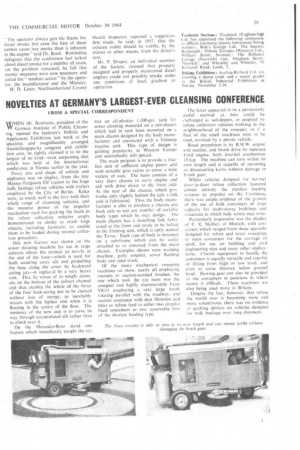NOVELTIES AT GERMANY'S LARGEST-EVER CLEANSING CONFERENCE
Page 41

If you've noticed an error in this article please click here to report it so we can fix it.
FROM A SPECIAL CORRESPONDENT WHEN Mr. Baumann. president of the VY German Institute of Public Cleansing, opened the Institute's Vehicle and Appliances Exhibition last week at the spacious and magnificently arranged, Ausstellungsparks congress and exhibition area, he rightly claimed it to be the largest of its kind--even surpassing that which was held at the international conference in Vienna earlier in the year.
Every size and shape of vehicle and appliance was on display, from the tiny Massey-Ferguson Elf tractor to the huge bulk haulage refuse vehicles with trailers employed by the City of . Berlin. Kuka were, as usual, well to the fore with their whole range of cleansing vehicles, and the massive power of the impeller mechanism used for packing the loads in the refuse collection vehicles amply demonstrated its ability to crush large objects, including furniture, to enable them to be loaded during normal collection procedure.
One new feature was shown on the sewer cleaning machine for use in large culverts where the normal jet nozzle at the end of the hose—which is used for both scouring away silt and propelling the hose along the sewer by backward acting jets—is replacal by a very heavy unit. This, by virtue of its weight alone. sits on the bottom of the culvert channel and thus enables the whole of the force of the four back-acting jets to be exerted without loss of energy, as inevitably occurs with the lighter unit when it is floating in the centre of the flow. The tendency of the new unit is to carve its way through accumulated silt rather than to climb over it.
On the Mercedes-Benz stand one feature which immediately caught the eye was an all-plastics 1,100-gal, tank for sewer cleaning mounted on a sub-chassis which had in turn been mounted on a main chassis designed by the body manufacturer and associated with a Unimog tractive unit. This type of design is gaining popularity in Western Europe and undoubtedly will spread.
The main purpose is to provide a tractive unit of sufficient engine power and with suitable gear ratios to cover a wide variety of uses. The basis consists of a very short chassis to carry engine and cab with drive direct to the front axle. At the rear of the chassis, which protrudes only slightly behind the cab, a link unit is fabricated. Thus the body manufacturer is able to produce a chassis and back axle to suit any number of variable body types which he may design. The main chassis has a matching link fabricated at the front and ready to be bolted to the Unimog unit, which is aptly named the Torso. Each type of body is mounted on a sub-frame which can he easily attached to or removed from the main chassis. Examples shown were washing machine, gully emptier. sewer flushing body and open truck.
Of the many mechanical sweeping machines on show, nearly all employing vacuum or suction-assisted brushes, ihe one which took the eye most was the compact and highly manceuvrable Faun V8/1I employing a very large brush rotating parallel with the roadway, and suction assistance with dust filtration and litter or refuse feed to either two circular fixed containers or two removable bins of the dustless loading type. The latter appeared to be a particularly useful method at bins could. be exchanged at sub-depots, or emptied by refuse collection vehicles working in the neighbourhood of the sweeper; or if a fleet of the small machines were to be used, serviced by a parent vehicle.
Road propulsion is by. B.M.W. engine and suction, and brush drive by separate Ford engine, both internal. combustion 10 h.p. The machine can turn within its own length and is capable of mounting or dismounting kerbs without damage to brush gear.
Whilst vehicles designed for normal dour-to-door refuse collection featured almost entirely the dustless loading systems so popular on the Continent, there was ample evidence of the growth of the use of -bulk containers of large capacity for multi-storey buildings and situations in which bulk refuse may arise.
Particularly impressive was the display of F. X. Meiller, of Munich, with containers which ranged from those specially designed for refuse and street sweepings to open containers for the carriage of spoil, for use on building and civil engineering sites and many other applications. Chassis equipment to handle the containers is equally versatile and_ capable of lifting from high, or low level, and even at some distance below ground level. Slewing gear can also be provided to site containers in positions in which access is difficult. These machines are also being used more in Britain.
Despite the fact, however, that refuse the world over is becoming more and more voluminous, there was no evidence of packing devices on vehicles designed for bulk haulageover long distances.












































































































